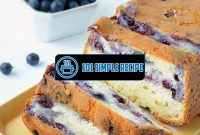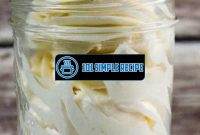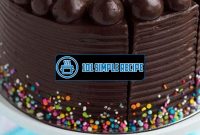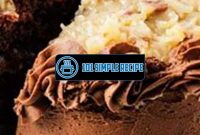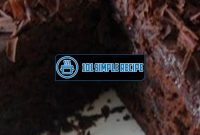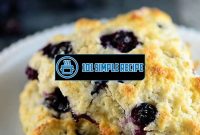If you’re craving the warm and comforting taste of freshly baked bread but don’t have any yeast on hand, don’t worry! We’ve got you covered with a delicious bread recipe that doesn’t require yeast. This easy homemade baking solution will have you enjoying a loaf of bread in no time. Whether you’re a beginner or an experienced baker, this recipe is perfect for anyone looking to satisfy their bread craving without the need for yeast. So grab your ingredients and let’s get baking!
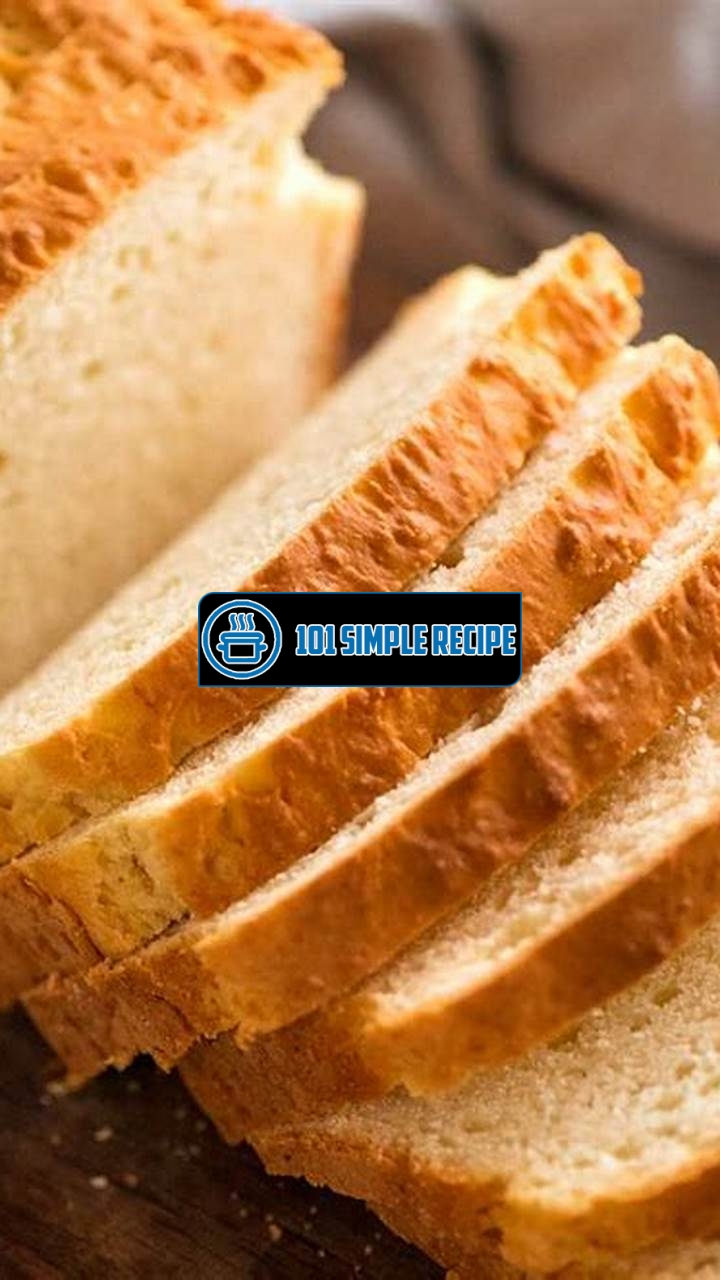
Understanding Yeast-Free Bread Recipes
Understanding yeast-free bread recipes opens up a world of possibilities for your homemade baking adventures. Whether you’re avoiding yeast due to dietary restrictions or simply want to try something new, yeast-free bread recipes offer unique characteristics and benefits that are worth exploring.
Yeast-free bread recipes rely on alternative leavening agents instead of traditional yeast. These recipes often produce denser bread with a different texture and flavor profile compared to yeast-based bread. While yeast provides a light and airy texture, yeast-free bread is typically more compact and hearty.
One of the key benefits of yeast-free bread is its simplicity. Without the need to wait for the yeast to activate or proof, you can save time and enjoy fresh bread in a shorter amount of time. Yeast-free bread also tends to have a longer shelf life, making it a great option for meal prepping or storing for later consumption.
Additionally, yeast-free bread recipes are suitable for individuals with yeast allergies or sensitivities. By eliminating yeast from your baking, you can indulge in delicious homemade bread without any adverse reactions.
Why Choose a Yeast-Free Bread Recipe
There are several reasons why you might choose a yeast-free bread recipe. First and foremost, yeast-free bread allows individuals with yeast allergies or sensitivities to enjoy freshly baked bread without any health concerns. By exploring these recipes, you can still enjoy the pleasure of homemade bread while accommodating your dietary needs.
Another reason to choose a yeast-free bread recipe is the simplicity and convenience it offers. Traditional bread recipes that require yeast may involve multiple proofing stages, which can be time-consuming. With yeast-free recipes, you can simplify the baking process and have fresh bread on the table in no time. This is particularly useful for individuals who lead busy lives but still want to enjoy the taste and aroma of homemade bread.
Different Types of Yeast-Free Bread
Yeast-free bread recipes come in various forms, each with its own unique characteristics. Some popular types of yeast-free bread include soda bread, sourdough bread, and quick bread.
Soda bread is a traditional Irish bread made with baking soda as the leavening agent. It has a dense texture and a slightly tangy flavor. Sourdough bread, on the other hand, is made using a naturally occurring yeast starter. While technically considered yeast-free because commercial yeast is not used, sourdough bread does contain wild yeast. It boasts a complex flavor profile and a chewy texture.
Quick bread, as the name suggests, is a type of bread that can be made quickly without the need for yeast or lengthy proofing time. It is leavened using baking powder or baking soda and often includes ingredients like fruit, nuts, or chocolate chips. Quick breads are versatile and can be enjoyed as both savory and sweet treats.
Alternative Ingredients for Yeast-Free Baking
When it comes to yeast-free baking, there are several alternative ingredients that can be used to achieve the desired rise and texture. These ingredients include baking powder, baking soda, buttermilk, sour milk, yogurt, and vinegar.
Baking powder and baking soda are commonly used as leavening agents in yeast-free bread recipes. Baking powder contains both an acid and a base, which react when combined with moisture to produce carbon dioxide bubbles, resulting in the bread’s rise. Baking soda, on the other hand, requires an acidic ingredient like buttermilk, sour milk, yogurt, or vinegar to create the necessary chemical reaction for leavening.
By exploring different yeast-free bread recipes and experimenting with alternative ingredients, you can uncover a wide variety of flavors and textures that will satisfy your taste buds and dietary preferences.
The Science Behind Yeast-Free Baking
Yeast-free bread recipes have gained popularity in recent years, as more people are seeking alternatives to traditional yeast-based recipes. Understanding the science behind yeast-free baking can help you achieve delicious, homemade bread without the need for yeast.
How Yeast-Free Bread Rises
While yeast is a crucial ingredient in traditional bread recipes, yeast-free bread relies on other mechanisms for rising. One key factor is the use of chemical leavening agents, which create gas and cause the bread to expand during the baking process.
The most common chemical leavening agent used in yeast-free recipes is baking powder. Baking powder consists of baking soda, an alkaline compound, and an acidic ingredient, typically cream of tartar. When combined with moisture, such as water or milk, the acid and base react to produce carbon dioxide gas. This gas gets trapped in the dough, causing it to rise and create a light, airy texture in the finished bread.
Important point: The use of baking powder as a leavening agent allows you to skip the lengthy proofing process required when using yeast. This results in a quicker and more convenient baking experience.
Chemical Leavening Agents in Yeast-Free Recipes
Beyond baking powder, there are other chemical leavening agents that can be used in yeast-free bread recipes. Baking soda is one such option, which is a pure form of sodium bicarbonate. When combined with an acid like vinegar or lemon juice, baking soda produces carbon dioxide gas, causing the bread to rise.
An alternative to baking soda is cream of tartar. When combined with baking soda, cream of tartar acts as an acidic ingredient, reacting with the baking soda to generate carbon dioxide gas. Cream of tartar is commonly used in recipes that require a more delicate rise, such as soufflés and meringues.
In addition to these chemical leavening agents, some yeast-free bread recipes also incorporate sourdough starter. Sourdough starter is a fermented mixture of flour and water that contains wild yeast. The yeast in sourdough starter helps with the rising process and adds a distinct flavor to the bread.
Important point: Using different chemical leavening agents in yeast-free bread recipes allows for variety in taste and texture. Experimenting with different combinations can result in unique and delicious bread creations.
Understanding Gluten-Free Yeast-Free Bread
For individuals with gluten intolerance or celiac disease, gluten-free yeast-free bread is a great alternative. Gluten is a protein found in wheat and other grains and is responsible for the elastic texture in traditional bread. However, gluten-free yeast-free bread recipes require alternative flours and binding agents to achieve a similar texture.
Common gluten-free flours used in these recipes include rice flour, almond flour, and tapioca flour. These flours have different properties compared to wheat flour, often resulting in a denser and more crumbly texture in the finished bread. To compensate for the lack of gluten, binding agents such as xanthan gum or psyllium husk are used to improve the bread’s structure and prevent it from crumbling.
Important point: Gluten-free yeast-free bread provides a viable option for those with dietary restrictions or preferences. It allows individuals to enjoy homemade bread without compromising their health or dietary needs.
By understanding the science behind yeast-free baking, you can confidently experiment with different recipes and ingredients, knowing how they will affect the rise, texture, and flavor of your bread. Whether you’re avoiding yeast, gluten, or simply seeking new baking techniques, yeast-free bread can be a delicious and satisfying alternative. Happy baking!
Mastering the Yeast-Free Bread Making Process
When it comes to baking delicious bread without yeast, mastering the process is key. With the right techniques and adjustments, you can create fluffy, homemade bread that will satisfy your cravings. In this article, we will guide you step-by-step through the yeast-free bread making process, ensuring that your final result is both tasty and easy to make. Let’s get started!
Preparation and Mixing Techniques
Before diving into the bread making process, it’s important to prepare your ingredients and understand the mixing techniques involved.
- Gather the necessary ingredients: flour, baking powder, salt, milk, and any additional flavorings or add-ins you desire. Having them ready will streamline the process.
- Measure the ingredients accurately: Precision is crucial, especially with dry ingredients like flour and baking powder. Use a kitchen scale or measuring cups to ensure you have the right amounts.
- Sift the dry ingredients: This step helps remove any lumps and ensures even distribution of the leavening agent (baking powder) throughout the flour.
- Mix the wet and dry ingredients: Combine the sifted dry ingredients with the wet ingredients, such as milk or water, and any additional flavorings. Use a spatula or wooden spoon to gently fold the mixture until it forms a soft dough.
By following these preparation and mixing techniques, you’ll set a solid foundation for your yeast-free bread.
Baking and Cook Time Adjustments
When baking bread without yeast, certain adjustments to the cooking time and temperature are necessary for optimal results. Pay attention to the following:
- Modify the baking temperature: Unlike yeast bread that requires high temperatures initially, yeast-free bread benefits from a moderate temperature throughout the baking process. Preheat your oven to 350°F (175°C) for a better outcome.
- Extend the baking time: Without yeast, the bread may take longer to rise and develop a golden crust. Increase the baking time by around 10-15 minutes, but keep an eye on the bread to prevent over-browning.
- Check for doneness: To determine if the bread is fully cooked, insert a toothpick into the center. If it comes out clean or with a few crumbs, your bread is ready. If the toothpick has wet batter on it, continue baking for a few more minutes.
With these adjustments, you’ll achieve a perfectly baked yeast-free bread every time.
Troubleshooting Common Issues
While the yeast-free bread making process is relatively straightforward, you may encounter some troubleshooting issues along the way. Here are a few common problems and their solutions:
| Issue | Solution |
|---|---|
| The bread is dense and heavy. | Increase the amount of baking powder used to help the bread rise. Additionally, ensure your oven is preheated adequately before baking. |
| The bread is too dry. | Try adding a little more liquid (milk or water) to the dough during the mixing process. This will increase moisture content and result in a softer texture. |
| The bread has a bitter taste. | Check the expiration date of your baking powder and replace it if necessary. An expired leavening agent can lead to an unpleasant taste. Alternatively, consider reducing the baking powder slightly. |
Remember, practice makes perfect. Don’t be discouraged if your first attempts at yeast-free bread don’t turn out exactly as expected. Experiment with different techniques and ratios until you find the perfect combination for your taste preferences.
By following these tips and techniques for mastering yeast-free bread making, you’ll enjoy delicious homemade bread whenever you desire. Happy baking!
Exploring Flavorful Variations
When it comes to yeast-free bread recipes, the possibilities are endless. You can experiment with a range of flavors and ingredients to create unique and delicious bread that will impress your family and friends. In this article, we will explore some exciting twists and flavor combinations that will take your homemade baking to the next level.
Sweet and Savory Combinations
Why settle for just plain bread when you can add a touch of sweetness or savory goodness to it? By incorporating different ingredients into your yeast-free bread recipes, you can create a delightful balance of flavors. Consider adding ingredients such as dried fruits, chocolate chips, or even a hint of honey to give your bread a touch of sweetness. On the other hand, if you prefer savory flavors, you can try adding ingredients like bacon bits, cheese, or herbs like rosemary or thyme. These combinations will add depth and complexity to your bread, making each bite a delightful experience.
Herbs, Spices, and Mix-ins
No yeast? No problem! You can enhance the taste of your bread by exploring a variety of herbs, spices, and mix-ins. Incorporating herbs like basil, oregano, or dill will infuse your bread with aromatic flavors that will tantalize your taste buds. Spices like cinnamon, nutmeg, or cardamom can be added for a warm and inviting aroma. If you want to take it a step further, you can also experiment with mix-ins like chopped nuts, seeds, or even dried cranberries. These additions will not only enhance the flavor but also provide a delightful texture to your bread.
Exploring Global Flavors
If you’re feeling adventurous, why not take your yeast-free bread on a global journey? Explore different cuisines and incorporate flavors from around the world into your recipes. For example, you can add cumin and coriander for an Indian-inspired bread, or try paprika and chorizo for a Spanish twist. The possibilities are endless, and you can let your creativity soar as you experiment with various global flavors. This will not only add excitement to your baking but also introduce you to new and delicious flavor profiles.
In conclusion, yeast-free bread recipes can be just as tasty and enjoyable as traditional ones. By exploring flavorful variations, such as sweet and savory combinations, herbs, spices, and mix-ins, and global flavors, you can elevate your homemade bread to new culinary heights. So, grab your apron, gather your ingredients, and get ready to indulge in the wonderful world of yeast-free baking!
Health Benefits of Yeast-Free Bread
When it comes to bread, yeast-free options are gaining popularity, and for good reason. Not only do they offer a variety of flavors and textures, but they also come with a range of health benefits that can contribute to a well-rounded diet. In this article, we will explore the nutritional advantages of yeast-free bread and how it can support your overall health and well-being.
Gluten-Free and Allergen-Friendly Options
One of the significant advantages of yeast-free bread is that it often comes in gluten-free variations. This is excellent news for individuals with gluten sensitivities or Celiac disease. By eliminating yeast from the recipe, gluten-free yeast-free bread becomes a safe and delicious option for those who need to adhere to a gluten-free diet. Additionally, these bread varieties can also cater to those with other allergies, such as dairy or egg allergies, making them a versatile and inclusive choice for many people.
Increased Digestibility and Gut Health
Yeast-free bread can provide better digestibility compared to traditional bread recipes. The absence of yeast means that it does not undergo the typical fermentation process, resulting in a lighter and easier-to-digest product. This can be particularly beneficial for individuals with sensitive stomachs or those who experience bloating or discomfort after consuming yeast-containing foods. Furthermore, the improved digestibility of yeast-free bread can contribute to better gut health by promoting a balanced microbiome and supporting efficient nutrient absorption.
Essential Nutrients Found in Yeast-Free Bread
While yeast is often associated with bread’s leavening properties, it does not contribute significantly to its nutritional value. In fact, yeast-free bread can still offer a range of essential nutrients necessary for a healthy diet. These include complex carbohydrates, dietary fiber, protein, vitamins, and minerals. By incorporating ingredients like whole grains, seeds, or nuts into yeast-free bread recipes, it becomes a nutritious and satisfying option that can provide sustained energy and support various bodily functions.
It is important to note that while yeast-free bread can offer numerous health benefits, it is always essential to choose quality ingredients and consume bread in moderation as part of a balanced diet. Additionally, individuals with specific dietary requirements or medical conditions should consult with a healthcare professional before making any significant changes to their diet.
Incorporating yeast-free bread into your diet can be a delicious and nutritious way to enjoy your favorite baked goods while reaping the many health benefits it offers. From gluten-free and allergen-friendly options to improved digestibility and essential nutrients, yeast-free bread has a lot to bring to the table.
So, next time you’re looking to whip up a batch of bread at home, consider trying a yeast-free recipe and discover a new world of flavors and nutritional advantages!
Frequently Asked Questions
Here are some frequently asked questions about bread recipes without yeast:
| No. | Questions | Answers |
|---|---|---|
| 1 | Can I make bread without using yeast? | Yes, you can make bread without yeast by using alternative leavening agents such as baking powder or baking soda. |
| 2 | What are the alternative leavening agents for yeast? | Apart from yeast, you can use baking powder, baking soda, or sourdough starter as alternative leavening agents in bread recipes. |
| 3 | Does bread without yeast rise? | Yes, bread made without yeast can still rise using other leavening agents. However, the texture and flavor may be slightly different from traditional yeast bread. |
| 4 | Are there any specific bread recipes that don’t require yeast? | Yes, there are various bread recipes that don’t require yeast, such as soda bread, beer bread, or quick bread recipes. |
| 5 | What can I use instead of yeast in pizza dough? | You can try using baking powder or baking soda as leavening agents in pizza dough if you don’t have yeast. |
| 6 | Can I make gluten-free bread without yeast? | Yes, you can make gluten-free bread without yeast by using alternative leavening agents and gluten-free flours. There are many gluten-free bread recipes available. |
Thanks for Reading!
We hope you enjoyed learning about how to make bread without yeast. Try these yeast-free recipes and discover unique flavors! Don’t forget to bookmark our page and visit again for more exciting recipes and cooking tips. Happy baking!
Jump to Recipe
Bread Recipe Without Yeast

Looking for a bread recipe without yeast? Discover delicious yeast-free bread recipes that are easy to make and perfect for any occasion.
- 2 cups all-purpose flour
- 2 teaspoons baking powder
- 1 teaspoon salt
- 1 cup milk
- 2 tablespoons olive oil
- Preheat the oven to 350°F (175°C). Grease a loaf pan.
- In a large bowl, whisk together the flour, baking powder, and salt.
- Add the milk and olive oil to the dry ingredients. Stir until well combined.
- Pour the batter into the greased loaf pan.
- Bake for 40-45 minutes or until a toothpick inserted into the center comes out clean.
- Remove from the oven and let cool in the pan for 10 minutes. Then, transfer to a wire rack to cool completely.

